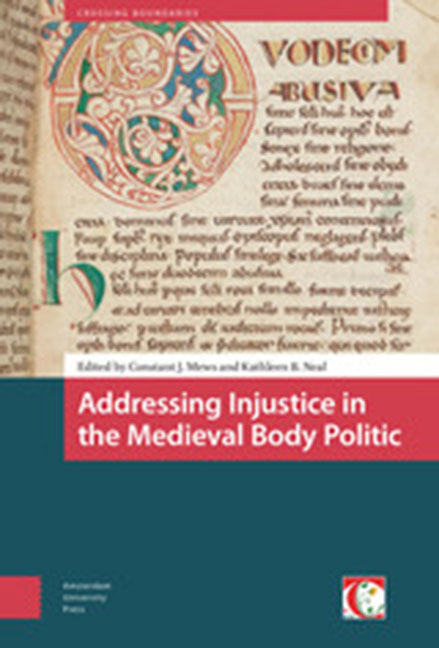Book contents
- Frontmatter
- Contents
- Acknowledgements
- Abbreviations
- Note on References
- List of Tables and Illustrations
- Introduction: Justice and its Abuse in the Medieval Body Politic
- 1 The De XII abusiuis saeculi: Contexts and Textual Traditions
- 2 The Irish Background to the De XII abusiuis saeculi
- 3 ‘Each in the Calling to Which They are Called’: Images of Authority in the De XII abusiuis saeculi
- 4 Transforming Irish Traditions: De XII abusiuis saeculi and Justice in the Frankish World, c. 750–1050
- 5 The Unjust King and the Negligent Bishop: Addressing Injustice in Eleventh and Twelfth-Century England and Germany
- 6 Reflecting on Abuses in Religious Life: From The Twelve Abuses of the Cloister to The Cloister of the Soul
- 7 Preaching the Body Politic: John of Wales and Franciscan Political Thought in the Late Thirteenth Century
- 8 Justice and Its Abuses in the Speculum justiciariorum
- 9 Addressing Abuses and Injustice in the Court of Philip the Fair: The De informatione principum of Durand of Champagne
- 10 ‘Perfect Justice Weighs Everything on a Balanced Scale’: Italian Friars on Equity, the Common Good, and the Commune c. 1270–c. 1310
- 11 Some Late Franciscan Rewritings of the Twelve Abuses
- Appendix: On the Twelve Abuses of the Age A Translation
- Bibliography
- Index of Biblical References
- Index of Manuscripts
- General Index
10 - ‘Perfect Justice Weighs Everything on a Balanced Scale’: Italian Friars on Equity, the Common Good, and the Commune c. 1270–c. 1310
Published online by Cambridge University Press: 14 February 2024
- Frontmatter
- Contents
- Acknowledgements
- Abbreviations
- Note on References
- List of Tables and Illustrations
- Introduction: Justice and its Abuse in the Medieval Body Politic
- 1 The De XII abusiuis saeculi: Contexts and Textual Traditions
- 2 The Irish Background to the De XII abusiuis saeculi
- 3 ‘Each in the Calling to Which They are Called’: Images of Authority in the De XII abusiuis saeculi
- 4 Transforming Irish Traditions: De XII abusiuis saeculi and Justice in the Frankish World, c. 750–1050
- 5 The Unjust King and the Negligent Bishop: Addressing Injustice in Eleventh and Twelfth-Century England and Germany
- 6 Reflecting on Abuses in Religious Life: From The Twelve Abuses of the Cloister to The Cloister of the Soul
- 7 Preaching the Body Politic: John of Wales and Franciscan Political Thought in the Late Thirteenth Century
- 8 Justice and Its Abuses in the Speculum justiciariorum
- 9 Addressing Abuses and Injustice in the Court of Philip the Fair: The De informatione principum of Durand of Champagne
- 10 ‘Perfect Justice Weighs Everything on a Balanced Scale’: Italian Friars on Equity, the Common Good, and the Commune c. 1270–c. 1310
- 11 Some Late Franciscan Rewritings of the Twelve Abuses
- Appendix: On the Twelve Abuses of the Age A Translation
- Bibliography
- Index of Biblical References
- Index of Manuscripts
- General Index
Summary
Abstract
The instability of Italian politics in the later thirteenth and early fourteenth centuries induced several mendicant writers, beginning with Thomas Aquinas and Giles of Rome, to seek remedies in ancient philosophy. They turned to Aristotle, Cicero, and Seneca, to address the systemic problems that disordered life and fomented injustice in the Italian communes. Two interlinked bundles of concepts, relating to equity, on the one hand, and to comune (It.: the common good, common goods, or the commune), on the other, were especially apt for thinking about how to manage relationships between individuals and groups. Although these ideas seem distant from the taxonomy and prescriptions of the De XII abusiuis saeculi, they shared the notion that justice requires a kind of balance in the body politic.
Keywords: Italy, communes, justice, disorder, equity, common good.
Occupying the lowest of the four registers of Giotto di Bondone's fresco panels adorning the walls of the nave of the Scrovegni Chapel in Padua, panels representing the seven virtues, on the south wall, face off against an equal number of opposing vices, on the north. In distinct contrast with the bright polychrome images above them which recount the Christian salvation story of the lives of Mary and Christ, the grisaille architectonic renderings of the virtues and vices not only make these appear to belong to the very structure of the building, but also serve, along with their accompanying inscriptions, to highlight their moralizing and didactic function. The seven virtues, moving in order from west to east, are the civic virtues Prudentia, Fortitudo, Temperantia, and Iustitia, followed by the theological virtues Fides, Karitas, and Spes. Opposing them, in the same order, are Stultitia, Inconstantia, Ira, Iniustitia, Infidelitas, Invidia, and Desperatio. Several things are worth noting about these two groups and the way they are arranged. First of all, the vices, with the exception of anger and envy, are not the canonical ‘deadly’ sins (the others being pride, greed, sloth, lust, and gluttony), but represent rather the opposite of the virtues with which they are paired. Secondly, the virtues are not arranged in the traditional order of prudence, justice, temperance, and fortitude, and faith, hope, and charity. And thirdly, and most importantly for our purpose, justice's non-canonical position is no mistake.
- Type
- Chapter
- Information
- Addressing Injustice in the Medieval Body Politic , pp. 283 - 310Publisher: Amsterdam University PressPrint publication year: 2023

